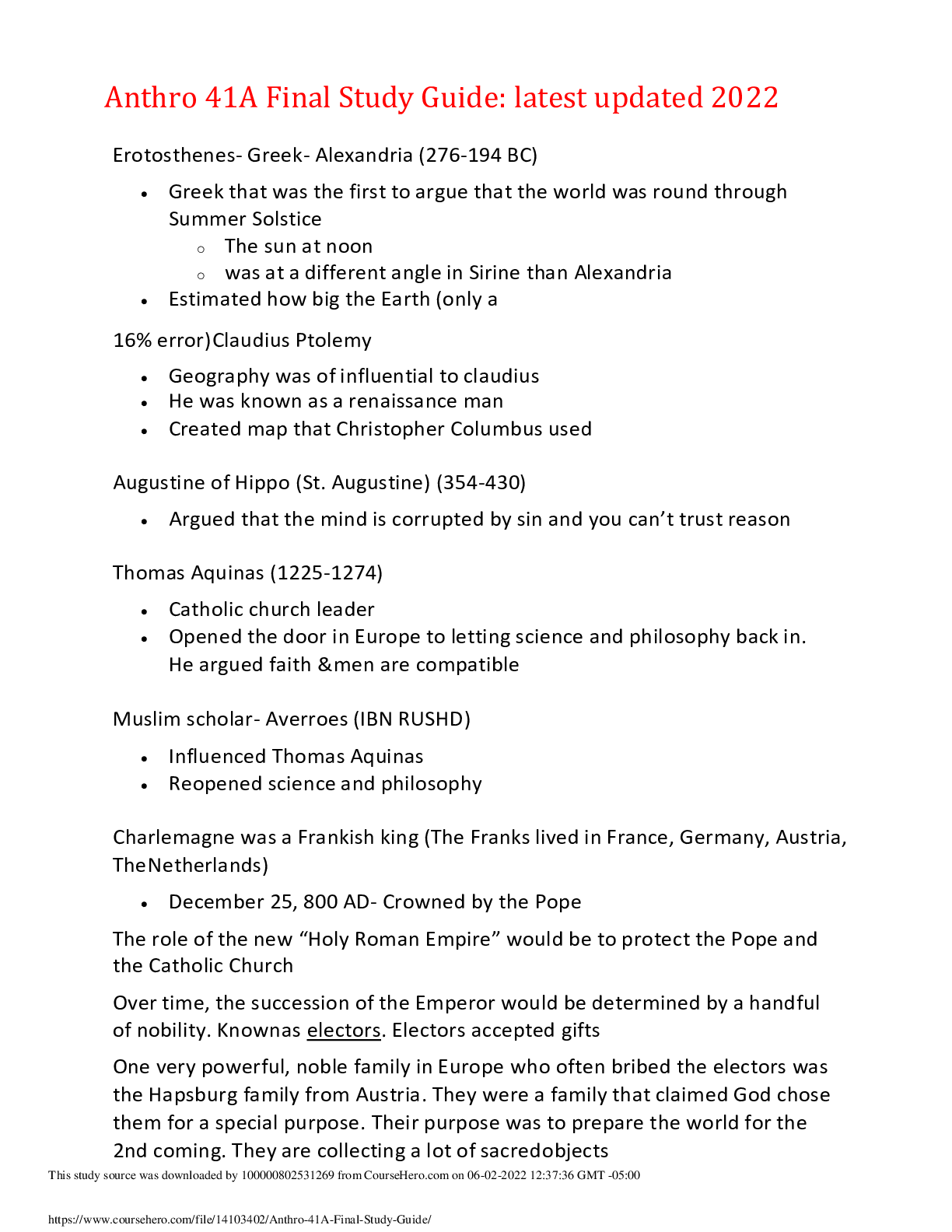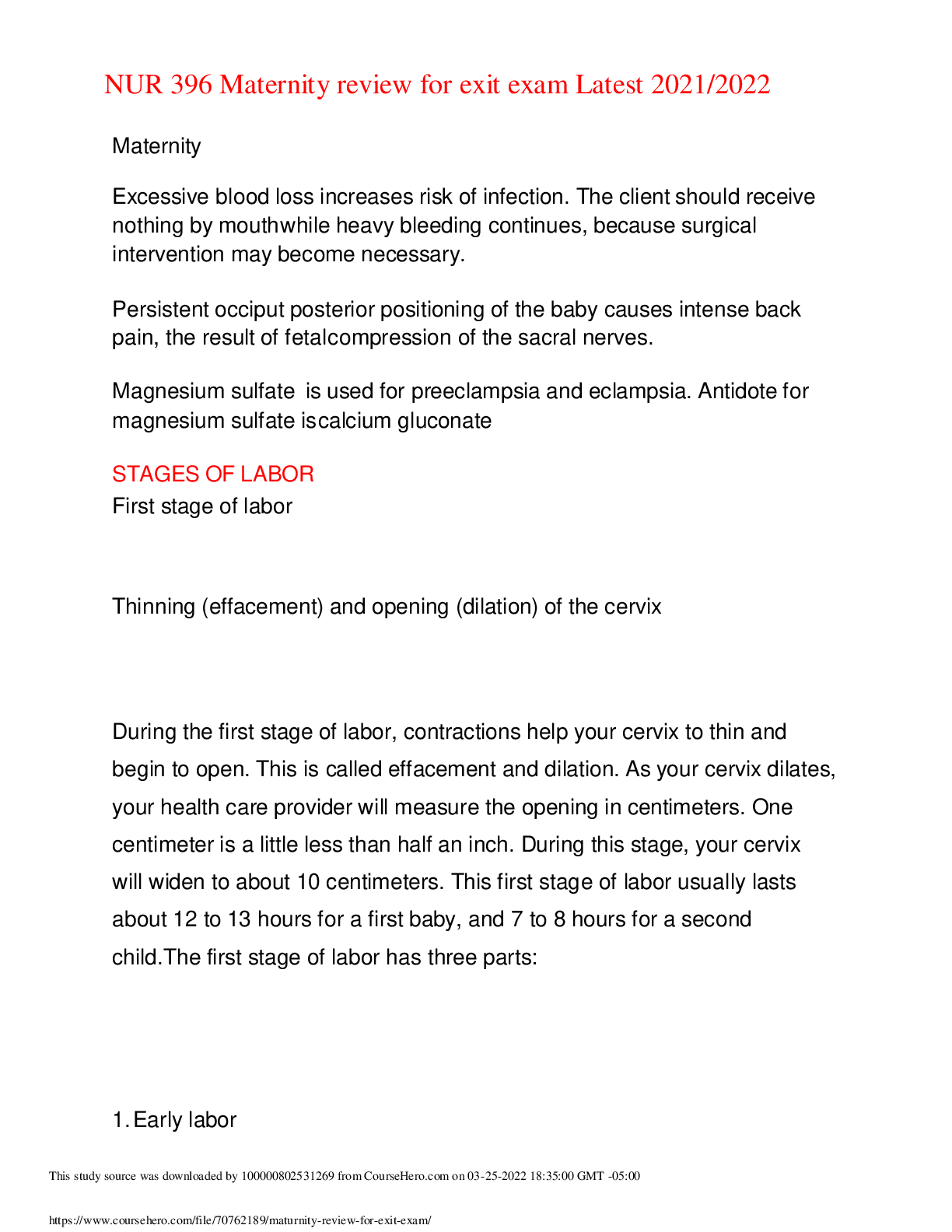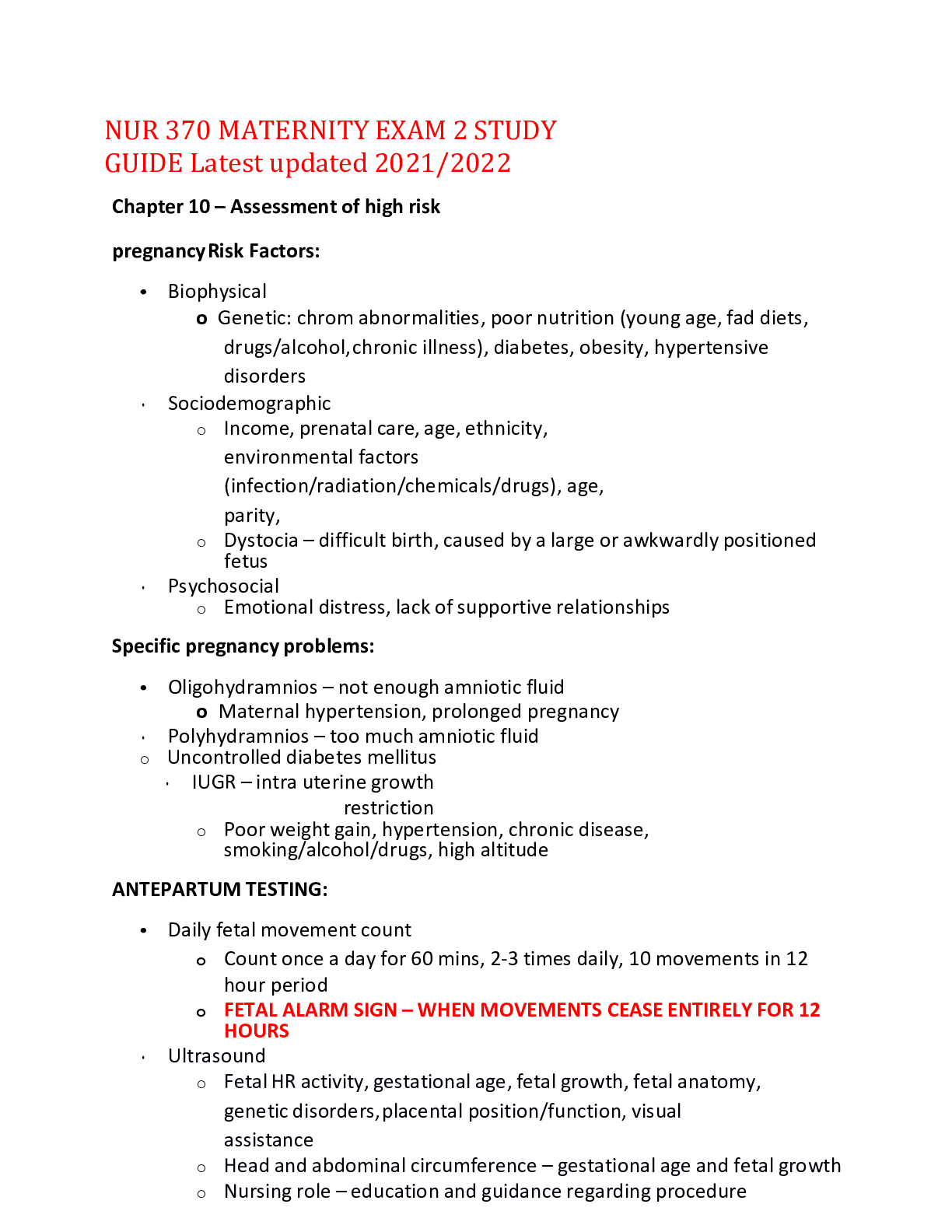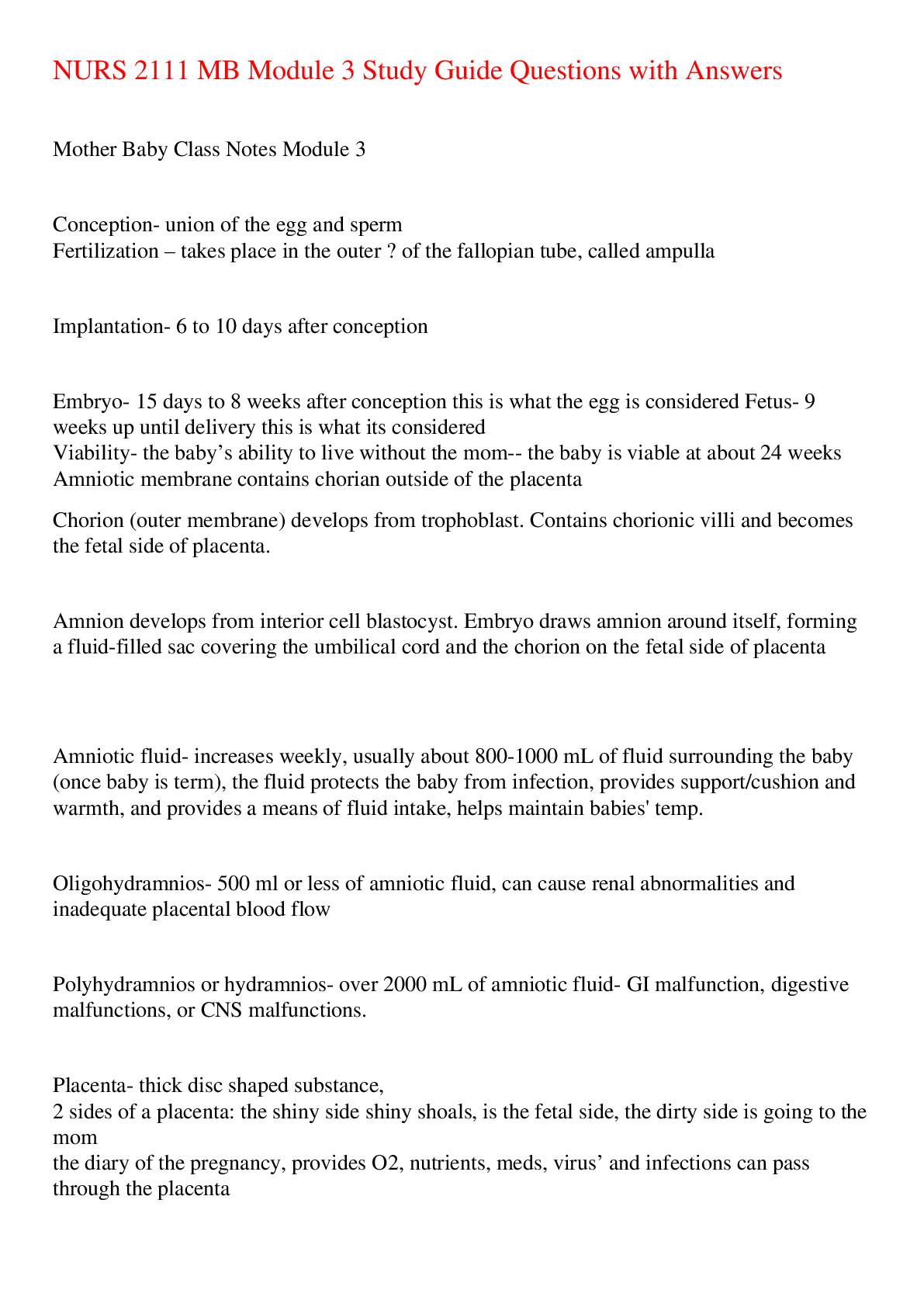Education > STUDY GUIDE > Early childhood Education 2 study guide 56 Questions with Answers,100% CORRECT (All)
Early childhood Education 2 study guide 56 Questions with Answers,100% CORRECT
Document Content and Description Below
Early childhood Education 2 study guide 56 Questions with Answers Custodial Care - CORRECT ANSWER care for a child's basic needs of physical,health, and safety. Not a curriculum based program. Ex:... Home care, hourly care, daycare etc Developmental care - CORRECT ANSWER Care that provides cognitive ( intellectual), social,emotional, physical,and moral development of the child. it curriculum based Ex: Montessori, preschool etc Comprehensive care - CORRECT ANSWER care that combines both custodial and developmental care of the child, It is curriculum based. May also include additional services such as dental, medical, and social services Ex: lab schools, head start, child care, on-site child Etc Hourly care - CORRECT ANSWER care that is open before, during, and after business hours to meet various working parent's schedules. Can also include babysitting, in -home, drop-off, care etc Montessori - CORRECT ANSWER a private school where the focus is learning by doing, hands on, and exploring material to guide their own education. Teachers must have 2 years of training Head Start Program - CORRECT ANSWER a federal program that provides academically focused preschool to students of low socioeconomic status preschool - CORRECT ANSWER an educational institution for children too young for elementary school for 3-5 year old is half day or less On-site child care - CORRECT ANSWER care that is located at the parents place of employment so parents can be near the child and is able to drop in home care - CORRECT ANSWER Provided in a persons home for 4 or more children but no more than 6 ,except for school age. Homelike atmosphere, low ratio, still has daycare philosophy. day care center - CORRECT ANSWER care provided for 13 or more children ages 4 weeks to 13 years. Laboratory Schools - CORRECT ANSWER A place where teachers in training are placed in a controlled situation to learn and practice the art of teaching real children. Not just a daycare center, but a provider of high quality child care and early childhood education in an environment where learning is child's play. Center Director - CORRECT ANSWER has to be at least 21 years old,have an associates degree or higher that include 12 semester credit hours of early child development courses. They could also have their CDA Teachers - CORRECT ANSWER must be at least 18 years old, an assistant can be 16 years old but must work under supervision of an 18 year old how many hours should a licensed caregiver complete - CORRECT ANSWER 20 hours Confidentiality - CORRECT ANSWER children's records kept secret along with all information about the children unless it is a need to know basis with written consent Proof of Immunizations - CORRECT ANSWER one has to have a current record of child's shot received child teacher ratio for 3 year olds - CORRECT ANSWER 1 teacher to every 12 children with max of 24 C.D.A license ( Child development associates license) - CORRECT ANSWER 480 hours of experience, 120 hours of education, and a completion on an exam child teacher ratio for 4 year olds - CORRECT ANSWER 1 teacher to every 15 children with max of 30 how many caregiver should be present with more than 8 children or 2 infants present - CORRECT ANSWER 2 caregivers teacher child ratio for 2 year olds - CORRECT ANSWER 1 teacher to every 7 kids max 14 kids child teacher ratio for birth to 2 years - CORRECT ANSWER 1 teacher to every 4 kids max 8 healthy environment - CORRECT ANSWER keeping a sanitary environment, washing of hands tables and bathrooms communicable disease - CORRECT ANSWER disease that is transmitted from one individual to another Examples of communicable diseases - CORRECT ANSWER pink eye, chicken pox what to do if child shows signs of illness - CORRECT ANSWER remove the child from the group and notify parents to come get them minor cuts - CORRECT ANSWER stop bleeding by applying pressure for 10 minutes, clean wound poisoning - CORRECT ANSWER call 911 bruises - CORRECT ANSWER use and ice pack and elevate choking - CORRECT ANSWER have child cough, then Heimlich maneuver minor burn - CORRECT ANSWER Cool the area and cover with a sterile gauze bandage. bloody nose - CORRECT ANSWER Pressure to pinch the nose shut and tilt head forward minor puncture wounds - CORRECT ANSWER flush out with water,or use tweezers fire procedure - CORRECT ANSWER exit building and find a safe spot Earthquake procedure - CORRECT ANSWER duck and cover intruder - CORRECT ANSWER lockdown how longs should one wash their hands - CORRECT ANSWER 20 seconds reporting child abuse - CORRECT ANSWER contact law enforcement, a hotline, or CPS SID - CORRECT ANSWER sudden infant death Danger zone temperature - CORRECT ANSWER 40-140 degrees DAP - CORRECT ANSWER Developmentally Appropriate Practice active learning - CORRECT ANSWER Learning by doing, for example writing, speaking, creating, participating in class cognative learning - CORRECT ANSWER the acquisition of mental information, whether by observing events, by watching others, or through language passive learning - CORRECT ANSWER Learning with minimal energy devoted to thinking about and elaborating information ( siiting ang listening) Auditory Learning - CORRECT ANSWER Learning by hearing and listening Visual Learning - CORRECT ANSWER Learning by seeing, reading, and watching tactile learning - CORRECT ANSWER those who learn best by using their senses of touch such as typing notes instead of writing them natural consequences - CORRECT ANSWER The effects that naturally tend to follow a particular behavior. logical consequences - CORRECT ANSWER reasonable consequences that are defined by parents objective factual statements - CORRECT ANSWER what actually happened subjective interpretive statements - CORRECT ANSWER ones opinion on what happened best shape for a room - CORRECT ANSWER rectangle or square scribbling stage - CORRECT ANSWER 1 1/2-3 years old Pre-Schematic Stage - CORRECT ANSWER 4-6 years; child produces first representative symbols for objects in the environment Schematic Stage - CORRECT ANSWER age 4-5 the third stage in children's art development, which is marked by using specific forms and shapes to represent elements of the environment realism stage - CORRECT ANSWER 5-6 year old they art starts to look more like people. [Show More]
Last updated: 2 years ago
Preview 1 out of 5 pages
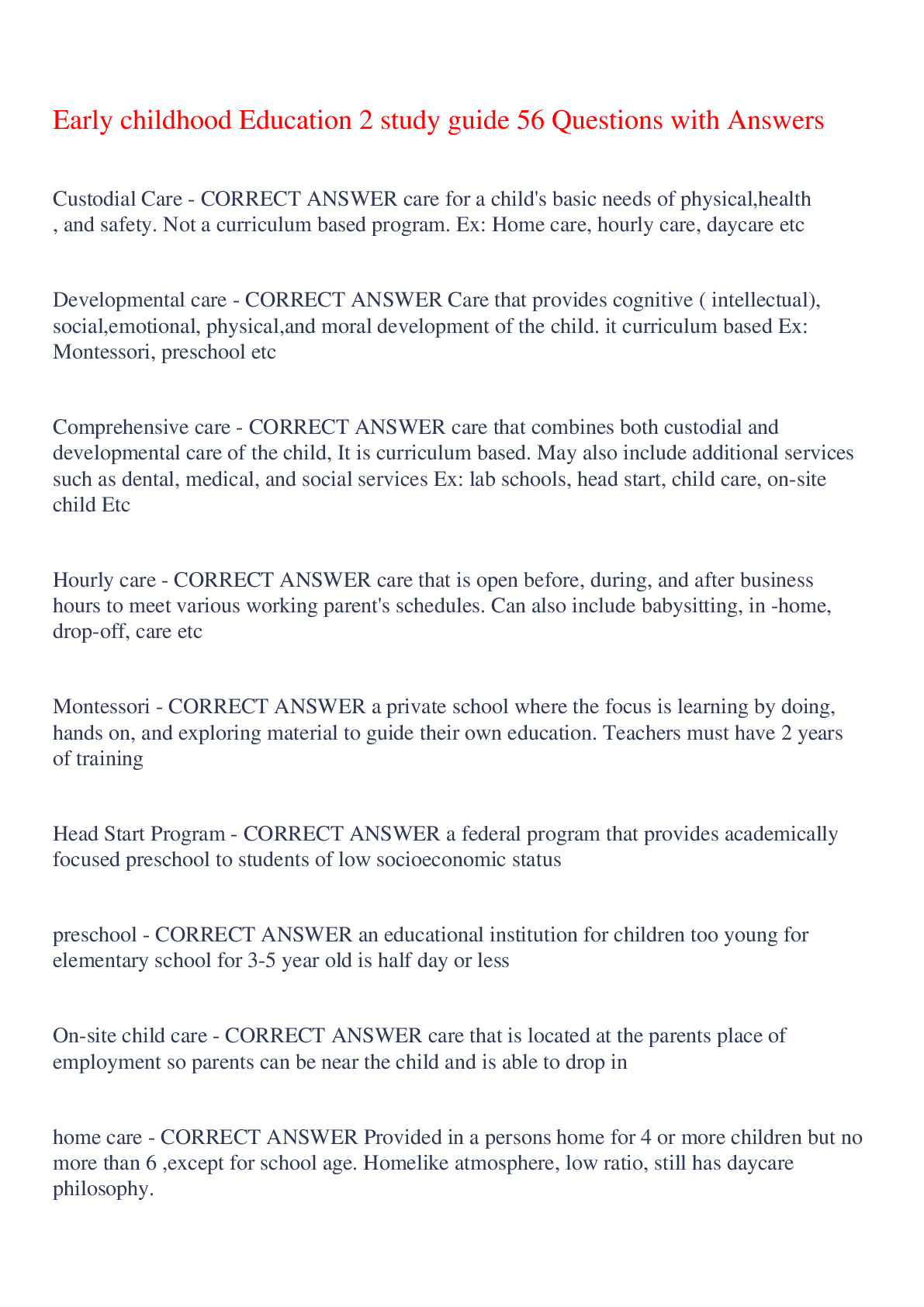
Buy this document to get the full access instantly
Instant Download Access after purchase
Buy NowInstant download
We Accept:

Reviews( 0 )
$8.00
Can't find what you want? Try our AI powered Search
Document information
Connected school, study & course
About the document
Uploaded On
Apr 29, 2023
Number of pages
5
Written in
Additional information
This document has been written for:
Uploaded
Apr 29, 2023
Downloads
0
Views
103


.png)




